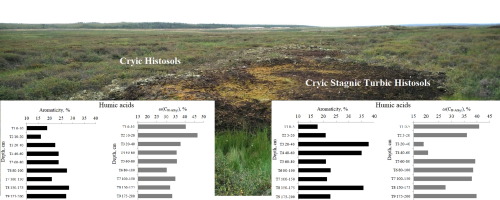R. Vasilevich, E. Lodygina, V. Beznosikova, E. Abakumov
“Molecular composition of raw peat and humic substances from permafrost peat soils of European Northeast Russia as climate change markers”
Science of The Total Environment 2018, 615 (In Progress, Available online 17 October 2017), 1229–1238
DOI: 10.1016/j.scitotenv.2017.10.053
Humic substances (HSs) from the mire peat soils of the forest-tundra zone of the European northeast part of Russia have been characterized in terms of molecular composition. This was accomplished using solid-state 13C nuclear magnetic resonance (13C NMR) techniques and electron spin resonance (ESR) spectroscopy. The composition depended on the intensity of cryogenic processes in the active layer, the quality of the humification precursors (the degree of peat material transformation), and the biochemical selection of aromatic fragments during humification. Humic acids (HAs) and fulvic acids (FAs) of the peat soils showed the presence of compounds with a low extent of condensation and a low portion of aromatic fragments, which increased with depth. A higher proportion of aliphatic carbon species was found in the HAs, indicating a low degree of organic matter stabilization. Based on the data from the two types of peat soils, we suggest that particular changes in the proportion of aromatic and unoxidized aliphatic fragments on the border of the bottom of the active layer and permafrost layers can be used as markers of current climatic change.
